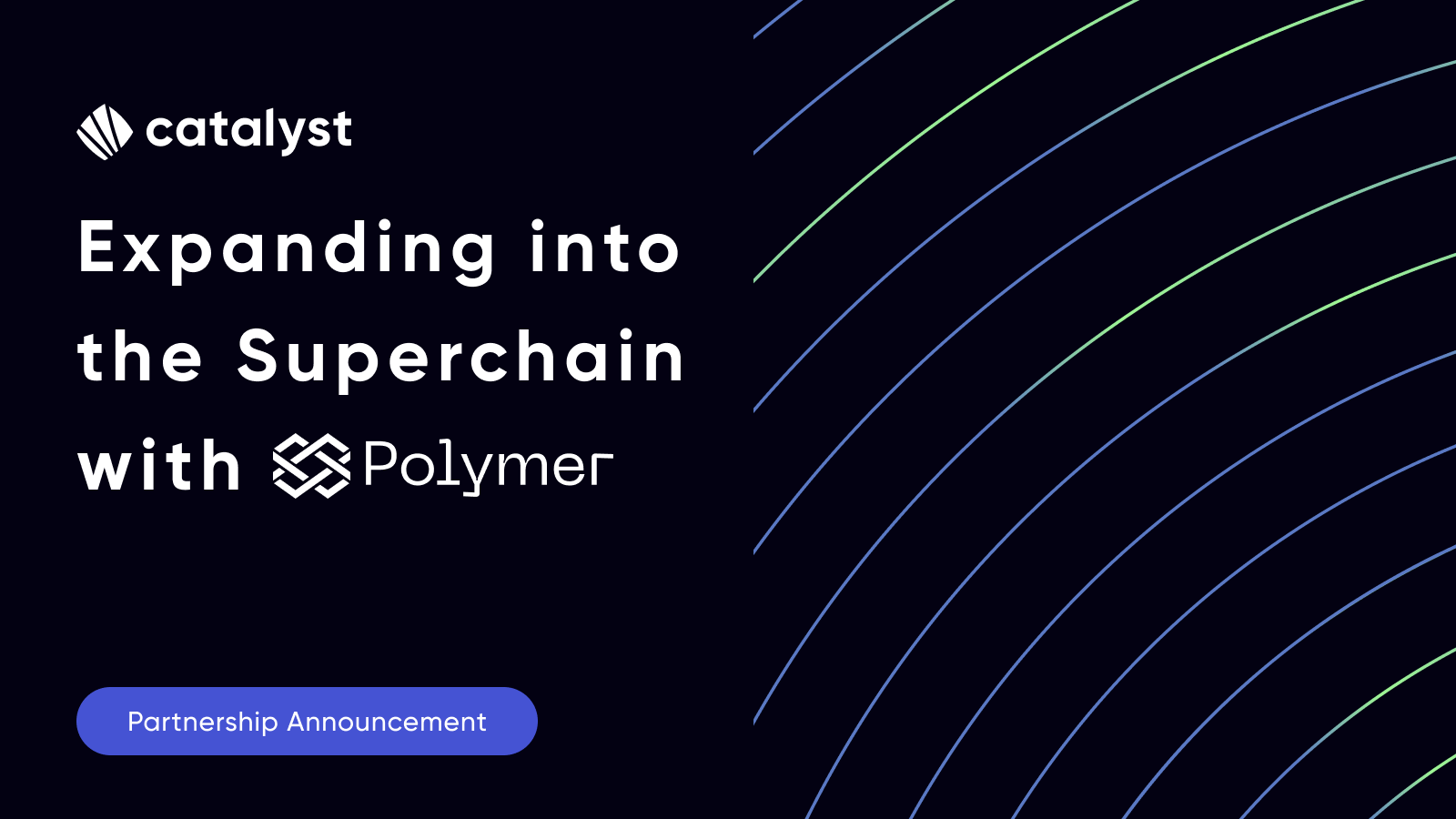Expanding into the Superchain with Polymer

Catalyst is excited to announce our integration with Polymer, the interoperability hub for Ethereum!
Our recent integration with Polymer significantly enhances the reach of the Catalyst Protocol and its liquidity. Building on Polymer means that Catalyst can now be seamlessly deployed across any blockchain that is part of the OP Stack ecosystem, right from the start!
This opens up the path to achieve universal cross-chain liquidity within the Optimism Superchain–with Catalyst as its liquidity backbone.
Why we love Polymer
Polymer is an Ethereum L2 created for the purpose of serving as Ethereum’s Interoperability Hub. Their mission is to enable seamless interoperability among all Ethereum rollups by using the Inter-Blockchain Communication (IBC) Protocol.
Polymer is built using the Cosmos SDK as its execution layer, which provides native IBC interoperability, allowing connected rollups to interact with each other seamlessly with trust-minimised cross-chain communication. Leveraging the OP Stack, Polymer offers settlement that facilitates efficient and secure transactions to and from Ethereum. This feature ensures that operations across various rollups are smoothly settled on the Ethereum mainnet.
To address the need for scalable data availability, Polymer incorporates EigenDA. This technology ensures that data across the network is readily available and can be accessed efficiently, enhancing the overall performance and reliability of the system.
At the core of its protocol, Polymer is an amalgamation of leading technologies: the settlement capabilities inherent in the OP Stack, the robust data availability provided by EigenLayer, and the advanced interoperability features sourced from the Cosmos SDK.
With Polymer, Catalyst is able to offer universal cross-liquidity within the Optimism Superchain ecosystem–and beyond! By leveraging Catalyst out-of-the-box for the OP Stack via Polymer, any OP chain will automatically connect to–and efficient swap liquidity between–one another.
Moreover, this integration is built with security and trust at the foundation. Polymer leverages the Inter-Blockchain Communication (IBC) Protocol as its cross-chain messaging infrastructure, which offers trust-minimised communication between participating chains–boosting the underlying security of Catalyst cross-chain transactions.
How does the integration work?
In order to understand how Catalyst builds on top of Polymer, we first need to understand how Catalyst works in general. Catalyst is comprised of four components:
- Pools that store digital assets on-chain.
- An Automated Market Maker (AMM) to coordinate asset pricing across different chains.
- The cross-chain message aggregator that transports and verifies the validity of the state of Catalyst pools.
- Solvers that provide fast liquidity between Catalyst pools
Consider a use case where Alice wishes to exchange her Ethereum ETH for MATIC on the Polygon PoS chain.
Alice begins by depositing her ETH into the Catalyst pool on Ethereum. Afterwards, the Unit of Liquidity is generated, reflecting Alice's ETH contribution in relation to the pool's total liquidity. This Unit of Liquidity serves as a critical parameter for executing the swap across chains.
Following this, a swap message is crafted–including the Unit of Liquidity–and passed to Catalyst's cross-chain message aggregator, which relays it to the target chain.
On the Polygon PoS chain, the Catalyst pool receives the swap message. The Unit of Liquidity is recalculated to determine the proportion of MATIC tokens that Alice will receive from the vault. Based on the calculated proportion, the appropriate amount of MATIC tokens is withdrawn from the vault and delivered to Alice's Polygon wallet.The cross-chain message aggregator currently connects interoperability protocols (& messaging standards like Polymer) in order to pass messages. The biggest advantage of using Polymer is that it directly leverages the native L2 bridge for security/settlement. In the future, the cross-chain message aggregator will be able to use any arbitrary cross-chain communication mechanism such as ZK storage proofs.
By integrating with Polymer, Catalyst gains seamless access to the expansive Superchain ecosystem. This integration allows for the effortless addition of new OP-stack rollups to the network without requiring any permissions. Furthermore, Polymer serves as the central interop hub for Superchain. This means any new pools Catalyst establishes on a new chain are automatically linked to the broader Superchain network through a single connection to this hub.
Relaying with GARP
In addition to the inclusion of Polymer in the cross-chain message aggregator, Polymer is also the second interoperability protocol to support GARP!
GARP is a general incentives framework for cross-chain relayers, created by the Cata Labs team and open-sourced for the broader crypto community to use at-will. With GARP, relayers can be comprehensively compensated for delivering packets across chains–ensuring censorship resistance and the timely delivery of information and state for cross-chain applications (like Catalyst).
In order for GARP to offer incentives for relayers, interoperability protocols need to be “aware” of its framework and payment scheme (i.e., so that relayers can be compensated for performing cross-chain packet deliveries). Polymer joins Wormhole as the first protocols to use GARP for more performant, more expressive, and more resistant cross-chain transactions!
About Cata Labs
Cata Labs is a software development company that contributes to open-source technology, including Catalyst Protocol. Cata Labs is backed by prominent investors such as Spartan Group, HashKey, Polygon and Circle. Check out our website here and read more here.
Catalyst Protocol is an AMM purpose-built to connect all chains. Its mission is to empower individuals to acquire any asset on any chain. Using Catalyst, any chain can swap assets with major blockchains like Cosmos, Ethereum and its rollups. Catalyst Protocol is operated by Catalyst Foundation, based in the Cayman Islands. Find out more about Catalyst Foundation at its website.
About Polymer Labs
Polymer Labs is a team of experienced distributed systems / infrastructure engineers, crypto OGs, and skilled business operators building the Ethereum Interoperability Hub, the first blockchain interoperability solution providing Ethereum rollups cross chain connectivity powered by Ethereum security. Polymer is also a contributor to Inter-Blockchain Communication and an active steward of the IBC community, including spearheading IBC Summit and OpenIBC.
Follow us on X and sign up for our newsletter on our website to learn more. If you would like to join us in building an interoperable future for crypto, check out our careers page.

